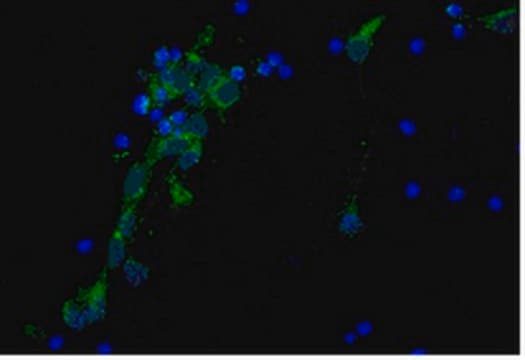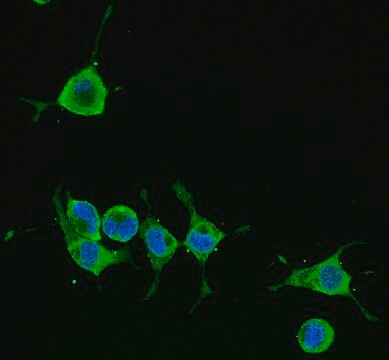ABN1643
Anti-APP Antibody, AEP-cleaved (373N)
serum, from rabbit
Synonyme(s) :
Amyloid beta A4 protein, 373N fragment, ABPP, 373N fragment, Alzheimer disease amyloid protein, 373N fragment, Amyloid precursor protein, 373N fragment, APP, 373N fragment, APPI, 373N fragment, Cerebral vascular amyloid peptide, 373N fragment, CVAP, 373N
About This Item
Produits recommandés
Source biologique
rabbit
Niveau de qualité
Forme d'anticorps
serum
Type de produit anticorps
primary antibodies
Clone
polyclonal
Espèces réactives
human, mouse
Réactivité de l'espèce (prédite par homologie)
porcine (based on 100% sequence homology), nonhuman primates (based on 100% sequence homology), canine (based on 100% sequence homology), guinea pig (based on 100% sequence homology)
Technique(s)
immunohistochemistry: suitable
western blot: suitable
Numéro d'accès NCBI
Numéro d'accès UniProt
Conditions d'expédition
ambient
Modification post-traductionnelle de la cible
unmodified
Informations sur le gène
human ... APP(351)
Description générale
Spécificité
Immunogène
Application
Western Blotting Analysis: A 1:1,000 dilution from a representative lot detected APP N-terminal fragment 373N in brain tissue lysates from 5XFAD familial AD transgenic mice, but not from AEP-knockout 5XFAD mice (Courtesy of Dr. Keqiang Ye, Emory University, U.S.A.).
Western Blotting Analysis: A representative lot detected an increased APP N-terminal fragment 373N in AEP-containing brain fractions from 5-month-old 5XFAD familial AD transgenic mice than wild-type mice (Zhang, Z., et al. (2015). Nat. Commun. 6:8762).
Western Blotting Analysis: A representative lot detected an age-dependent increase brain APP N-terminal fragment 373N in mice. Upregulated APP 373N level was seen in human AD brain samples when compared with age-matched non-AD brains (Zhang, Z., et al. (2015). Nat. Commun. 6:8762).
Western Blotting Analysis: A representative lot detected AEP-cleaved recombinant GST-APP N-terminal fragment, but not the uncleaved GST-APP or the cleaved C-terminal fragment (Zhang, Z., et al. (2015). Nat. Commun. 6:8762).
Western Blotting Analysis: A representative lot detected AEP-cleaved APP N-terminal fragment 373N in untransfected, but not AEP siRNA-transfected, HEK293 cells.
Neuroscience
Qualité
Western Blotting Analysis: A 1:1,000 dilution of this antiserum detected APP(1-585), but not APP(1-373) or full-length APP, GST fusion exogenously expressed in HEK293 cells.
Description de la cible
Forme physique
Stockage et stabilité
Handling Recommendations: Upon receipt and prior to removing the cap, centrifuge the vial and gently mix the solution. Aliquot into microcentrifuge tubes and store at -20°C. Avoid repeated freeze/thaw cycles, which may damage IgG and affect product performance.
Autres remarques
Clause de non-responsabilité
Not finding the right product?
Try our Outil de sélection de produits.
En option
Code de la classe de stockage
12 - Non Combustible Liquids
Classe de danger pour l'eau (WGK)
WGK 1
Point d'éclair (°F)
Not applicable
Point d'éclair (°C)
Not applicable
Certificats d'analyse (COA)
Recherchez un Certificats d'analyse (COA) en saisissant le numéro de lot du produit. Les numéros de lot figurent sur l'étiquette du produit après les mots "Lot" ou "Batch".
Déjà en possession de ce produit ?
Retrouvez la documentation relative aux produits que vous avez récemment achetés dans la Bibliothèque de documents.
Notre équipe de scientifiques dispose d'une expérience dans tous les secteurs de la recherche, notamment en sciences de la vie, science des matériaux, synthèse chimique, chromatographie, analyse et dans de nombreux autres domaines..
Contacter notre Service technique








